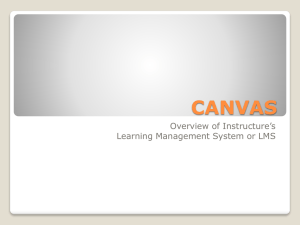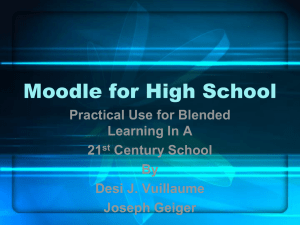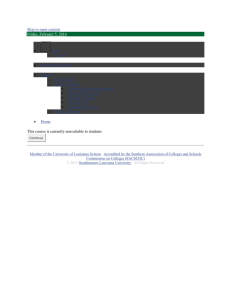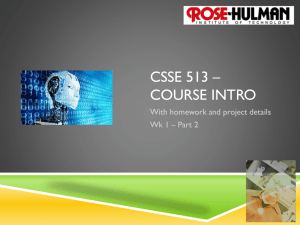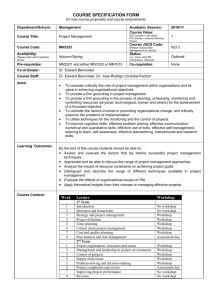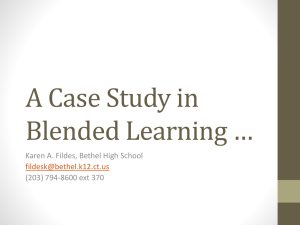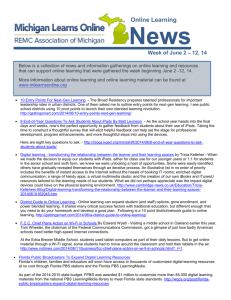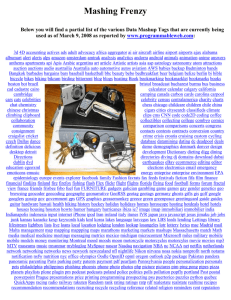September 29 MiLearnsOnline Newsletter
advertisement
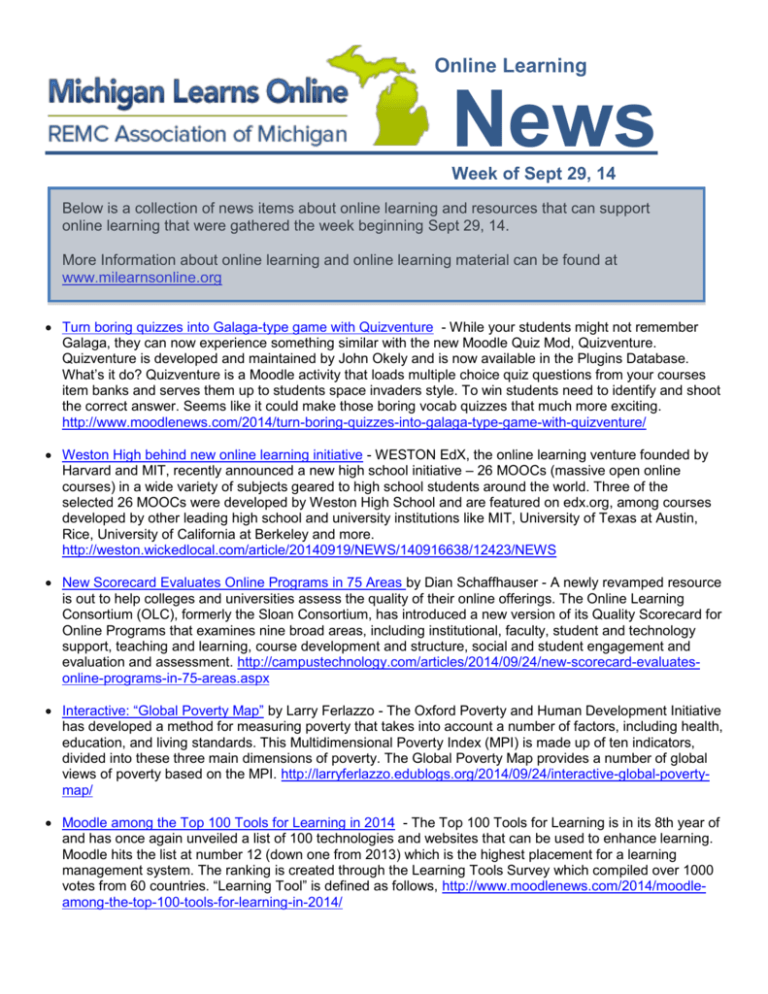
Online Learning News Week of Sept 29, 14 Below is a collection of news items about online learning and resources that can support online learning that were gathered the week beginning Sept 29, 14. More Information about online learning and online learning material can be found at www.milearnsonline.org Turn boring quizzes into Galaga-type game with Quizventure - While your students might not remember Galaga, they can now experience something similar with the new Moodle Quiz Mod, Quizventure. Quizventure is developed and maintained by John Okely and is now available in the Plugins Database. What’s it do? Quizventure is a Moodle activity that loads multiple choice quiz questions from your courses item banks and serves them up to students space invaders style. To win students need to identify and shoot the correct answer. Seems like it could make those boring vocab quizzes that much more exciting. http://www.moodlenews.com/2014/turn-boring-quizzes-into-galaga-type-game-with-quizventure/ Weston High behind new online learning initiative - WESTON EdX, the online learning venture founded by Harvard and MIT, recently announced a new high school initiative – 26 MOOCs (massive open online courses) in a wide variety of subjects geared to high school students around the world. Three of the selected 26 MOOCs were developed by Weston High School and are featured on edx.org, among courses developed by other leading high school and university institutions like MIT, University of Texas at Austin, Rice, University of California at Berkeley and more. http://weston.wickedlocal.com/article/20140919/NEWS/140916638/12423/NEWS New Scorecard Evaluates Online Programs in 75 Areas by Dian Schaffhauser - A newly revamped resource is out to help colleges and universities assess the quality of their online offerings. The Online Learning Consortium (OLC), formerly the Sloan Consortium, has introduced a new version of its Quality Scorecard for Online Programs that examines nine broad areas, including institutional, faculty, student and technology support, teaching and learning, course development and structure, social and student engagement and evaluation and assessment. http://campustechnology.com/articles/2014/09/24/new-scorecard-evaluatesonline-programs-in-75-areas.aspx Interactive: “Global Poverty Map” by Larry Ferlazzo - The Oxford Poverty and Human Development Initiative has developed a method for measuring poverty that takes into account a number of factors, including health, education, and living standards. This Multidimensional Poverty Index (MPI) is made up of ten indicators, divided into these three main dimensions of poverty. The Global Poverty Map provides a number of global views of poverty based on the MPI. http://larryferlazzo.edublogs.org/2014/09/24/interactive-global-povertymap/ Moodle among the Top 100 Tools for Learning in 2014 - The Top 100 Tools for Learning is in its 8th year of and has once again unveiled a list of 100 technologies and websites that can be used to enhance learning. Moodle hits the list at number 12 (down one from 2013) which is the highest placement for a learning management system. The ranking is created through the Learning Tools Survey which compiled over 1000 votes from 60 countries. “Learning Tool” is defined as follows, http://www.moodlenews.com/2014/moodleamong-the-top-100-tools-for-learning-in-2014/ Friday Institute Project Designs MOOCs for Educators by Tyler Nakatsu - With shrinking professional development budgets and trainings in short supply, educators are going online for news skills and techniques. The innovators at the Friday Institute for Educational Innovation at NC State University’s College of Education have recognized this trend by announced an offering of MOOC-Eds. What are MOOCEds? Massive, open, online courses for educators. http://gettingsmart.com/2014/09/friday-institute-projectdesigns-moocs-educators/ How to Develop a Sense of ‘Presence’ in Online and F2F Courses with Social Media by Debbie Morrison Presence is considered a central concept in online learning. ‘Presence’ in the online course is understood as the ability of people “to project their personal characteristics into the community, thereby presenting themselves to other participants as ‘real people’”. (Garrison, Anderson, & Archer, 2000, p. 89). One way of examining ‘presence’ online is through the Community of Inquiry (CoI) framework, a frequently referenced model that outlines three interdependent dimensions of presence: social, teaching and cognitive. When all three elements interact, it’s then that students are able to experience deep and meaningful learning. http://onlinelearninginsights.wordpress.com/2014/09/29/how-to-develop-a-sense-of-presence-in-online-andf2f-courses-with-social-media/ Teachers figure out when to turn technology on, and when to turn it off by Alexandria Neason - This summer, nearly 100 new and veteran teachers from the New York City public schools became students themselves. The subject? How to introduce blended learning into their classrooms? Blended learning combines online and teacher-led instruction. Instead of learning in a traditional, lecture style classroom, students use laptops or tablets to study independently and move through the curriculum at their own pace. But just handing out computers isn’t enough. Successful blended learning requires teachers to know which technology makes the most sense – and when to shut it off. http://hechingerreport.org/content/teachersfigure-turn-technology-turn_17476/ Time to Rewrite the Code, But How? - The shift to blended, personalized, and competency-based learning suggests a dramatic change in state education policy. Legislators at the NCSL Jobs Summit in San Jose last week recognized that their state education code is a patchwork of outdated provisions with a few recently won improvements. We discuss the 7 keys to education and employment outlined in Smart Cities. I suggested that states should plan to rewrite their education code. A couple veteran legislators pushed back and asked, “With all the competing pressures, how would that actually work today? Instructure Launching Free Learning Object Repository, Canvas Commons By David Nagel - Instructure has launched a limited pilot of Canvas Commons, a new learning object repository that integrates with the Canvas learning management system. Instructure is describing Canvas Commons as "a new platform that will enable educators to tap into the power of crowdsourcing and the social Web. Called Canvas Commons, it's a learning object repository where the best ideas, courses and curriculum can be freely shared — all seamlessly integrated into the Canvas LMS environment." http://campustechnology.com/articles/2014/09/25/instructure-launching-free-learning-object-repositorycanvas-commons.aspx Youtube Anywhere updated for Moodle 2.6 and 2.7 - If you’re a user of Youtube Anywhere , a quick and easy way to add webcam recording to your Moodle site via TinyMCE, the plugin has now been updated for both Moodle 2.6 and 2.7 as long as you’re using TinyMCE. No version for Atto is yet available. http://www.moodlenews.com/2014/youtube-anywhere-updated-for-moodle-2-6-and-2-7/ Monthly webinars: Learn to use the REMC MLO Portal First Wednesday starting in November http://tinyurl.com/learnmloportal And Don’t Forget: www.milearnsonline.org/giveandget The MiLearns Online Newsletter is archived at http://www.remc.org/projects/milearnsonline/resources/milearnsonline-newsletter-archive/
